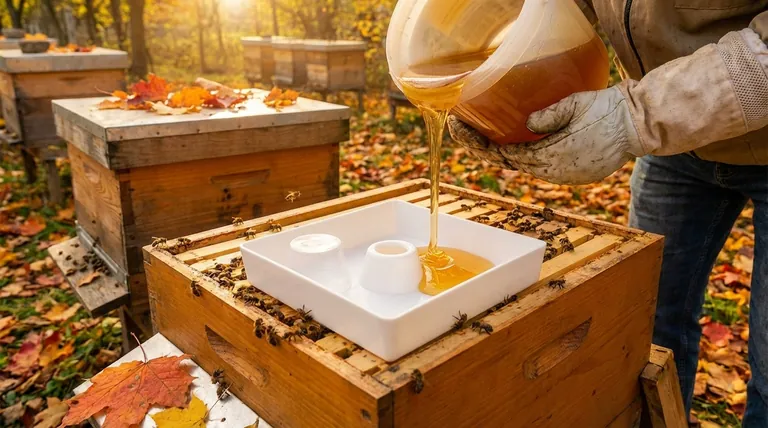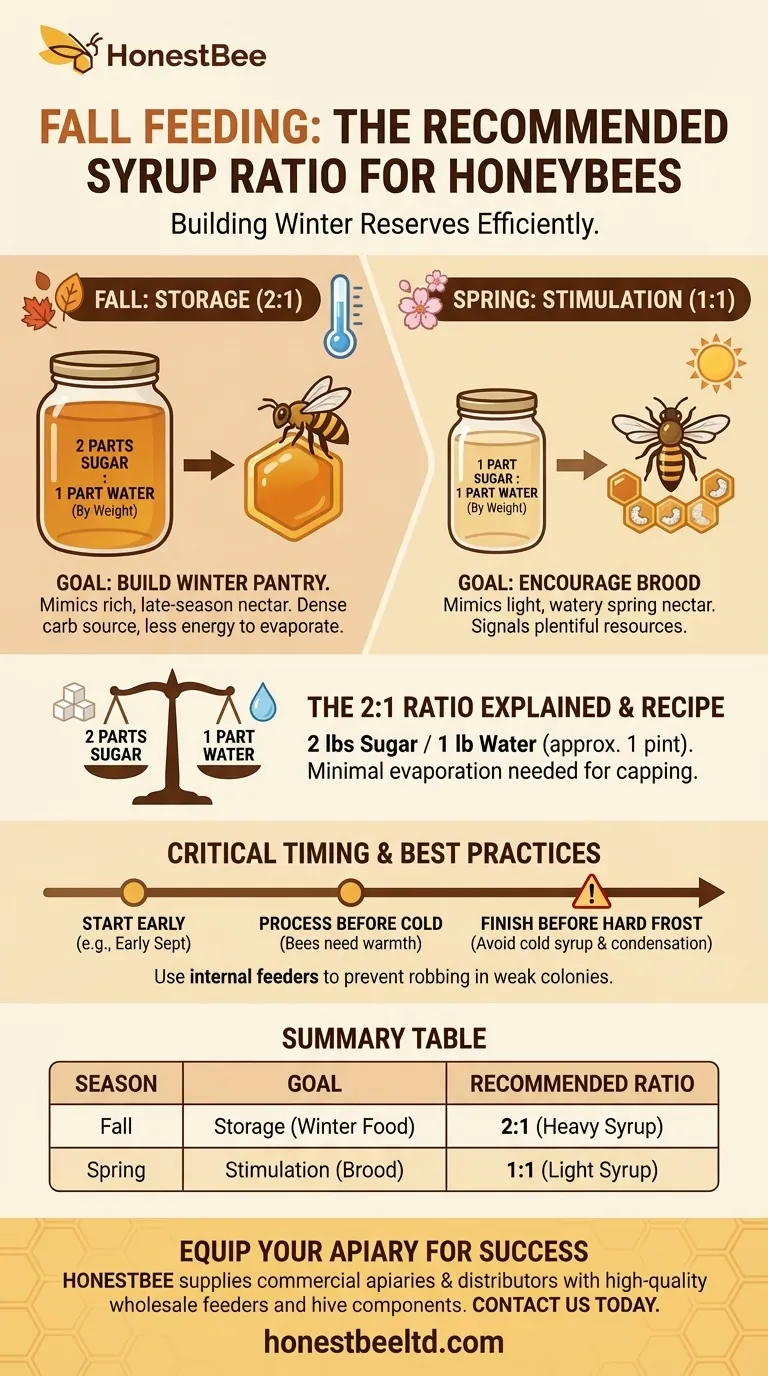For fall feeding of honeybees, the standard and recommended syrup ratio is 2:1, consisting of two parts sugar to one part water, measured by weight. This heavy syrup provides a dense carbohydrate source that bees can efficiently process and store as winter food, minimizing the energy they must expend evaporating excess water.
The core principle is simple: a thick, 2:1 syrup in the fall is for storage, helping bees build their winter pantry. A thin, 1:1 syrup in the spring is for stimulation, encouraging the queen to expand the brood nest.

Why the Ratio Changes with the Season
The nutritional needs of a honeybee colony are not static; they shift dramatically with the seasons. Your feeding strategy must align with their natural cycle to be effective.
The Goal of Fall Feeding: Building Stores
In autumn, the colony's primary objective is to accumulate enough food to survive the long, cold winter when foraging is impossible.
A heavy 2:1 syrup closely mimics a rich, late-season nectar flow. Its high sugar concentration makes it an ideal food source for this purpose.
The 2:1 Ratio Explained
The recipe for fall feed is 2 parts sugar to 1 part water, by weight.
A common mixture is 2 pounds of white cane sugar dissolved into 1 pound of water (which is equivalent to one U.S. pint or about 2 cups). Another way to measure is 1 kilogram of sugar per 625 milliliters of water.
Because the syrup is so dense, bees expend minimal energy evaporating the water content before capping it in the comb, making it a highly efficient way to build winter reserves.
Contrast with Spring Feeding
In spring, the goal is entirely different. You are not trying to build massive stores but to stimulate population growth.
A thin 1:1 syrup (1 part sugar to 1 part water by weight) mimics the light, watery nectar of early spring blossoms. This signals to the queen that resources are plentiful, encouraging her to ramp up egg-laying and expand the colony's workforce.
Critical Timing and Best Practices
Providing the right syrup is only half the battle; providing it at the right time is crucial for the colony's survival.
When to Start and Stop Feeding
Fall feeding should be completed before the weather turns consistently cold, ideally by the end of September in most Northern Hemisphere climates.
This timing is critical because the bees need sufficient warmth and time to process the syrup, reduce its moisture content, and cap the cells before clustering for winter.
Avoiding Common Mistakes
Feeding too late in the season is a significant risk. Cold syrup is difficult for bees to consume, and introducing large amounts of moisture into a hive during cold weather can lead to condensation and chill the brood.
Furthermore, ensure your colony is strong enough to defend itself. Open feeding or weak colonies can attract robber bees from other hives, creating a disastrous situation. Always use an internal feeder to minimize this risk.
Making the Right Choice for Your Goal
Your feeding strategy should always be dictated by the specific needs of your colony at a given time of year.
- If your primary focus is building winter food stores: Use a heavy 2:1 syrup and complete all feeding before the first hard frost.
- If your primary focus is stimulating spring brood production: Use a light 1:1 syrup to mimic an early nectar flow and encourage colony growth.
- If you are supporting a weak or newly established colony: A 1:1 syrup can provide immediate, easily digestible energy, but a transition to 2:1 is essential for winter preparation.
Providing your bees with the right resource at the right time is one of the most impactful actions a beekeeper can take.
Summary Table:
| Season | Goal | Recommended Syrup Ratio (Sugar:Water) |
|---|---|---|
| Fall | Storage - Build winter food reserves | 2:1 (Heavy Syrup) |
| Spring | Stimulation - Encourage brood production | 1:1 (Light Syrup) |
Ensure your apiary is prepared for winter with the right equipment. HONESTBEE supplies commercial apiaries and beekeeping equipment distributors with high-quality, wholesale-focused supplies. From durable internal feeders to essential hive components, we provide the tools for successful beekeeping. Contact us today to discuss your wholesale needs and equip your colonies for success.
Visual Guide

Related Products
- HONESTBEE Professional Hive Top Bee Feeder Feeding Solution
- HONESTBEE Round Hive Top Bee Feeder for Syrup
- HONESTBEE Entrance Bee Feeder Professional Hive Nutrition Solution for Beekeeping
- HONESTBEE Advanced Ergonomic Stainless Steel Hive Tool for Beekeeping
- Rapid Bee Feeder White Plastic 2L Round Top Feeder for 8 or 10-Frame Bee Hives
People Also Ask
- What safety features are included in top feeders? A Guide to Drowning Prevention and Hive Safety
- How is the plywood floor fitted into the hive-top feeder? Ensure Longevity with a Floating Floor Design
- Do I need an inner cover with a hive top feeder? Optimize Your Hive Setup for Healthy Bees
- What should be done with feeders and equipment after feeding bees? Essential Steps for Apiary Health
- What features make top feeders a reliable choice for beekeepers? A Guide to Safe, Efficient Hive Nutrition



















